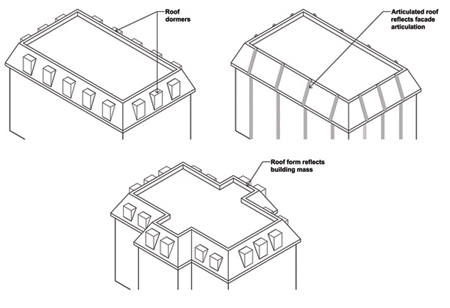New Orleans Comprehensive Zoning Ordinance
Printed: 4/23/2024 6:39:33 AM
15.3.B Building Design Standards
1. The following building design standards apply to development within the C-1, C-2, C-3, MU-1, MU-2, and LS Districts, with the exception of single and two family residential uses.
a. The primary entrances shall be oriented to the primary street.
b. The ground floor of newly constructed commercial buildings shall contain a minimum transparency of fifty percent (50%) on the primary street and windows shall be constructed of transparent glass. Opaque, highly tinted, or reflective glass is prohibited. Transparency into the building shall be maintained. Any window signs shall consist of individual letters and numerals without the use of any background.
c. Security bars, if installed, shall be on the inside of windows. Roll-up or accordion security grilles are permitted on the ground floor when constructed of a see-through, non-solid material. The Casing shall be painted to match the building and shall not damage or obscure architectural detailing.
d. Plain mansard roofs are prohibited. Decorative mansard roofs are permitted on buildings with a minimum wall height of two (2) stories. (See Figure 15-2: Examples of Decorative Mansard Roofs).
e. Decorative elements having historically functional purposes, such as shutters, balconies, windows, and doors, shall be operational.
f. Any structure designed for a ground floor non-residential use shall be designed with a minimum ceiling height of twelve (12) feet, except for parking areas.
g. Loading areas for retail anchor stores of twelve thousand (12,000) square feet in gross floor area or more are required to be located in the rear.
h. Outlot buildings shall be designed with showcase windows and entrances oriented to the street.
i. Secondary access points are encouraged from rear parking lots. Facades that abut parking areas and contain a public entrance shall include pedestrian walkways.
j. When a shopping center is located behind a parking lot, a street presence for the shopping center shall be created by locating part of the center and/or outlot buildings near the lot line at the primary street corner or the shopping center entrance. When the center’s frontage on the primary street exceeds two-hundred fifty (250) feet in width, part of the center and/or outlot buildings shall hold at least fifty percent (50%) of the front lot line. (See Figure 15-3: Building Siting).
k. The following building materials are prohibited on exterior elevations visible from the public right-of-way. However, such materials may be used as part of decorative or detail elements, or as part of the exterior construction that is not used as a surface finish material.
1. Exterior insulating finish systems (EIFS)
2. Stuccato Board
3. Vinyl
FIGURE 15-2: EXAMPLES OF DECORATIVE MANSARD ROOFS

FIGURE 15-3: BUILDING SITING

2. The following standards shall apply to all sites that meet the applicability thresholds of Section 4.5 Development Plan and Design Review:
a. A cohesive shopping center character is required through the use of coordinated hardscape treatment, such as special paving materials, lighting, and street furniture, coordinated signs and landscape. Pedestrian areas shall include shade trees and seating areas.
b. Public entrances shall be articulated from the structure mass.
c. Shopping centers with frontage on the primary street that exceeds two-hundred fifty (250) feet in width and a lot depth of three-hundred (300) feet or more are encouraged to construct an access road with parallel parking along that primary street. If an access road is constructed, retail storefronts shall be oriented to this access road.
d. Structures shall use decorative roof elements, such as projecting cornices, to define public entrances, main pedestrian routes or activity areas.
e. When visible from the public right-of-way (excluding alleys), façades shall include architectural features to avoid the appearance of blank walls facing the street. These include, but are not limited to, changes in the wall plane of at least six (6) inches, changes in wall texture or masonry patterns, colonnade, columns, or pilasters.
f. Windows along the street shall be set back into or projected out from the façade to provide depth and shadow.
g. Green roof, blue roof, and white roof designs are encouraged.
Ord. 29126, 8-12-22, ZD016/22